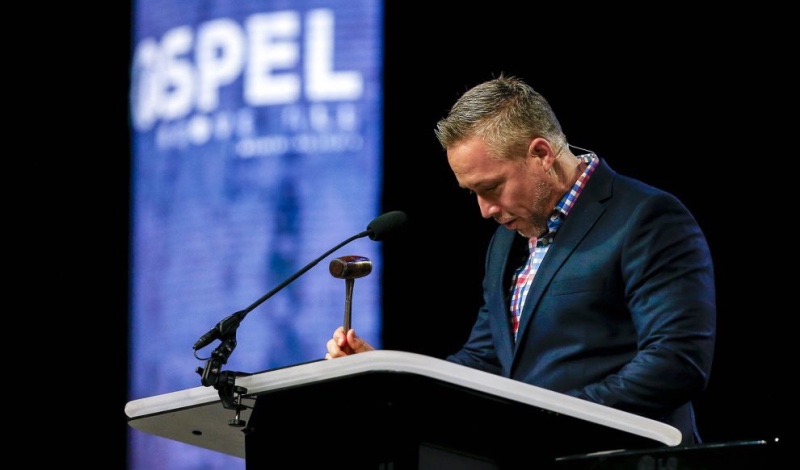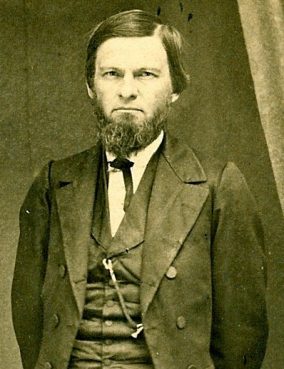Birmingham, Alabama, US
RNS
When the annual meeting of the Southern Baptist Convention opens, a little-noticed ritual usually occurs.
An SBC executive hands a gavel to the person elected president the previous June. That act officially opens the meeting.

Southern Baptist Convention President JD Greear brings the annual meeting of the Southern Baptist Convention to order using the 1872 Broadus gavel, named for John A Broadus, a slaveholder, at the Birmingham-Jefferson Convention Complex in Birmingham, Alabama, on 11th June. PICTURE: Butch Dill/RNS
SOUTHERN BAPTISTS FACE SEX ABUSE CRISIS WITH LITANY OF LAMENT
The last session of the annual meeting of the Southern Baptist Convention opened with thousands of Baptists lamenting for what their president, JD Greear, labeled a crisis of sexual abuse.
Following along on large screens around the Legacy Arena, women, men, pastors, lay people and survivors took turns reading words drawn from the Biblical books of Psalms and Lamentations.
At the end of the litany on Wednesday they jointly prayed for divine intervention.
“Therefore, our God, hear the prayer and the petitions of your servant,” they said. “Make your face shine on your desolate sanctuary for the Lord’s sake. Listen closely, my God, and hear. Open your eyes and see our desolations.”
After days of discussions in which survivors described nearly unspeakable crimes against them, members of the nation’s largest Protestant denomination turned to a 45 minute period of prayer and planning about what they could do next.
“The failures of the way of man brought us to the place we are as a denomination on this issue of abuse,” said Greear at the meeting that was attended by more than 8,000 delegates, or messengers. “It is only the movement of God, we know, that can rescue us from it. It’s not just policy. It’s not just statements and changes. It’s the spirit of God working in us.”
He asked pastors in the audience to make room in their calendars over the next year to take an eight-step “Care Well” challenge that includes training a team in their congregations to lead their response to building awareness and assisting survivors.
“You don’t have room not to include this in your calendar,” Greear told them, drawing applause. “The impact of this moment on our Gospel witness is too critical for you to minimise, to postpone or to ignore this.”
The day before, Baptists overwhelmingly voted to adopt changes to the convention’s governing documents that will bring greater visibility to their desire to disaffiliate with churches that do not handle instances of abuse properly. The messengers also created a new, standing credentials committee that can consider whether churches are not “in friendly cooperation” if they “act in a manner inconsistent with the convention’s beliefs regarding sexual abuse”.
Near the end of the session that began with the responsive reading, Baptists adopted a resolution on “the evil of sexual abuse”.
“We affirm that sexual abuse is not only a sin to be disciplined in the context of the church,” they said, “but also a crime to be prosecuted in the context of civil government.”
– ADELLE M BANKS/RNS
It turns out that gavel, the so-called 1872 Broadus gavel, has a questionable history – especially in a church body that has sought racial reconciliation within its ranks.
The gavel is named for John A Broadus. He was a slaveholder, a believer in white superiority and a founding faculty member of Southern Baptist Theological Seminary.
“At the 1863 meeting of the Southern Baptist Convention in Augusta, Georgia, Broadus drafted resolutions pledging Southern Baptist support for the Confederacy,” reads the SBC flagship seminary’s December report on slavery and racism in its history.
On Wednesday, the day this year’s SBC meeting concluded, Roger “Sing” Oldham, spokesman for the SBC Executive Committee, confirmed in an interview that the Broadus gavel is named for the former slaveholder.
The nation’s largest Protestant denomination was founded in 1845 in defense of missionaries who owned slaves.
Asked about the juxtaposition of the SBC’s current emphasis on racial reconciliation – it featured a panel discussion on the subject on Tuesday – and its use of a gavel from a leader connected to slavery, Oldham said: “I think that that’s a very valid point to raise. I’m not sure that it’s been considered.”
Broadus is known most, Oldham said, for books he wrote about homiletics, or the art of preaching.
“Primarily he is thought of by most Baptists as being the premier teacher of preachers and preaching,” he said. “But your point’s a very valid point for us to consider.”
Southern Seminary President R Albert Mohler, Jr, who supports truth-telling about history rather than removing names from buildings or monuments, said that artifacts connected to American slavery are a part of the SBC’s past.
“That’s just, lamentably and tragically, a part of the history of the Southern Baptist Convention,” said Mohler. “The option is either to have a John Broadus gavel or to have no gavels from the convention’s founding era.”
Mohler said Broadus was known in Baptist circles as the pastor of famed missionary Lottie Moon and far beyond the Baptist fold for his definitive book, On the Preparation and Delivery of Sermons.
“You’re dealing with someone who in the Baptist world looms as large as the Founding Fathers do in the United States of America,” he said.
A historical note about the gavel included in the denomination’s 1939 Annual explains how it first was presented at an SBC meeting on 9th May, 1872.
“The Rev J A Broadus of South Carolina, presented to the Convention a mallet for the use of the President, which he had brought from Jerusalem for that purpose,” according to the note.
It was eventually engraved, in part, with words about how the mallet was a symbol of Jesus’ ministry, stretching from the Jordan River where he was baptised to the Mount of Olives from which it is believed he ascended to heaven: “The head of Olive Wood from Jerusalem and the handle of Balsam Wood from the Banks of the Jordan.”
Rev Robert E Wilson, historian of the SBC’s National African American Fellowship, said it is important to “separate the mallet from the man”. The gavel symbolised Jesus, while the man who gave it to the convention was known for racist policies.
“I don’t want to throw the baby out with the bathwater,” Wilson said. “As a historian, at this point I have to say that no, I’m not ready to say that it should not be used because of who presented it.”

John Albert Broadus (1827-1895)
Shaun Cross, an African American church planter in Washington, DC, who attended the SBC meeting as a guest because his fledgling church is so new, said the gavel represents the longevity of the denomination but could also be viewed as a sign of disenfranchisement.
“Symbols have power,” he said. “I think there would need to be serious consideration about the potential of competing symbols.”
Pastor Dwight McKissic, a Texas minister who worked to get Southern Baptists to adopt resolutions condemning white supremacy and repudiating the Confederate flag, went further.
“It should not be even used in the next gathering of the SBC,” he said. “The reality of the gavel does not match the current rhetoric of the convention regarding race.”
Broadus eventually repudiated US slavery in 1882, the Southern Seminary report states, and argued a decade later against lynching.
“‘The thing is wrong,’ he said, ‘getting worse,’ and it was ‘high time’ for southern whites to ‘come out and condemn this business of lynching,’” he told the Louisville Courier-Journal in the late 1800s, according to the report.





